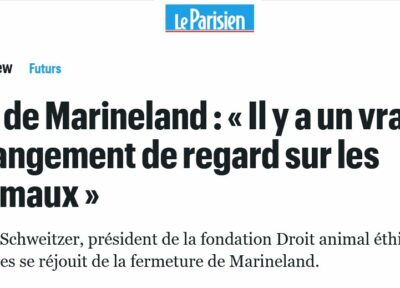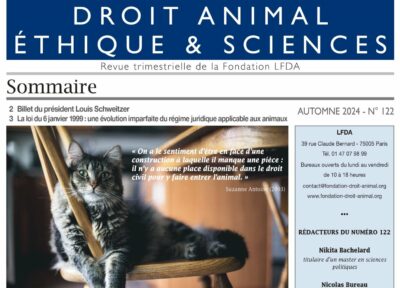by Daniel M. Weary, Jesse Robbins, David Fraser & Marina A.G. von Keyserlingk
Animal Welfare Program, University of British Columbia, Vancouver, Canada
[DOWNLOAD ARTICLE] [Download complete PDF 6.2Mo]
To cite this article (suggested): Weary D.M., Robbins J., Fraser D. & von Keyserlingk M.A.G., « Is Animal Welfare Better on Smaller Farms? » [PDF file], In: Hild S. & Schweitzer L. (Eds), Animal Welfare: From Science to Law, 2019, pp.133-139.
Abstract
Concerns about the welfare of farm animals often revolve around the issue of farm size. Many critics suggest that animals on larger farms are less likely to receive individual attention and instead are treated only as units of production, and that the shift to larger farms results in a decline in standards of care and ultimately in the quality of life for the animals. In this talk we outline the historical background of this criticism, drawing parallels with the earlier debate over the shift from an agrarian to an industrial society. We also argue that farm size influences different aspects of animal welfare in different ways. For example, larger farms may permit more specialized and professional management of animal health, but make it difficult to provide access to pasture for dairy cows. We also review the limited empirical literature linking farm size and welfare and conclude that available research provides little support for any simple relationship. In conclusion, increases in farm size provide opportunities to improve the welfare of farm animals but also create welfare risks. Policy and advocacy efforts, instead of trying to reverse the increase in farm size, would be better directed toward generalizing the welfare benefits and minimizing the risks.
Farm size – the dominant narrative
A common feature of discussion around farm animal welfare is that farm size necessarily affects the welfare of animals on that farm, with larger farms perceived to have poorer welfare than smaller farms. This view has been popularized in books including Fast Food Nation (2001), Omnivores Dilemma (2006) and Animal Factory (2010), that consider larger farms more likely to be under corporate (rather than family) ownership, and more likely to pursue profit at the expense of harms to the environment, to the workers, and to the animals.
For those that ascribe to this view the news is bad as farm size has grown, and shows every indication of continuing to grow rapidly. The United States Department of Agriculture (USDA) keeps good statistics on such matters, so we provide these numbers below. These U.S. changes are likely similar to those seen in other developed, industrial economies (that are based on largely of feeding grain to animals, such changes may be less pronounced in forage-based systems; Fraser, 2005).
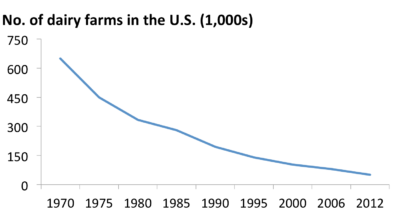
Figure 1 illustrates data gleaned from these USDA surveys for dairy cows. As can be seen, the number of farms that produce milk has declined rapidly over the past 40 years, even though the total number of cows has changed little. Thus, the pattern of declining farm numbers is due to the smallest farms leaving the industry and the remaining farms becoming progressively larger.
The reasons for these changes are complex (see Fraser, 2005), but it seems likely that the forces at work will be difficult to counteract. If we wish to convince farmers and policy makers to reverse or even slow these changes we will need compelling arguments. Indeed, even if we focus on welfare concerns (the topic of this report) we can identify multiple factors. Here we separate these welfare related concerns into three broad categories: 1) that the technologies inherent to large farms are detrimental to the animals, 2) that due to dilution of worker effort over a larger number of animals, the standard of care provided to individuals animals will decline, and 3) that some especially beneficial management practices, like access to the outdoors, may become impractical once farms reach a certain critical size. Below we critically review some of the evidence relating to all three types of concern, using where possible, examples and evidence from our own work on dairy cattle. However, before we begin with this list we will first introduce some first-person evidence that has motivated our interest and questions regarding the dominant narrative that “big = bad” in terms of farm size and animal welfare.
Farm size and lameness in dairy cattle – cracks in the dominant narrative?
Over much of the past decade our research group at the University of British Columbia has been interested in lameness in dairy cows. This ailment is perhaps one of the greatest threats to dairy cow welfare; lameness is painful, long lasting and prevalent (many surveys show that 30% or more lactating dairy cows are lame).
One theme of this recent work has been to compare commercial farms in an attempt to identify features of these farms that reduce the risk that cows will become lame. Our studies of this type have shown a great range in lameness rates in our home province of British Columbia (Ito et al., 2010), elsewhere in North America (von Keyserlingk et al., 2012), and in China (Chapinal et al., 2014 a). In each of the regions we have examined, we have found that some farms are able to manage lameness remarkably well, with only a small percentage of animals lame, while other farms struggle in controlling lameness, sometime with more than half the cows on the farm showing clinical signs of lameness (i.e. impaired gait).
Our primary goal in this work was to engage farmers in discussion about lameness, with the ultimate aim of motivating changes that help reduce the rates of lameness on their farms. In this aspect we have seen some success (Chapinal et al., 2014 b), although clearly much still needs to be done. To help better inform changes in management we have also statistically assessed the relationship between farm practices and lameness rates. This work has identified a number of practices that can reduce the risk of lameness on farms. For instance, in north-eastern US the availability of deep-bedded lying stalls and the use of pasture were associated with lower rates of lameness. Our work has also shown that the risk factors vary according to the region. For example, in California where the use of deep-bedded stalls was universal (thus removing poorly bedded mats and mattresses as a risk), we were able to identify other factors as important, including the quality of the bedding management and the use of rubber flooring in the milking parlour (Chapinal et al., 2013).
Given that farm size is perceived to negatively affect welfare outcomes, we also included this factor into each of our statistical models. However, instead of finding more lameness on larger farms we found the opposite result. As illustrated in Figure 2, cows on the largest farms were at a lower risk of being lame than were cows on the smaller farms. Indeed, we have found this counterintuitive pattern in a variety of regions with farm size varying across two orders of magnitude (from less than 100 to almost 6,000 cows). We also found a very similar pattern for cows on large farms in China (Chapinal et al., 2014 a).
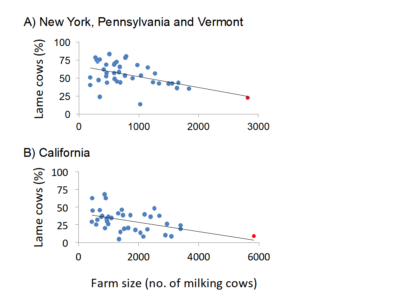
Welfare risk on larger farms
Are technologies inherent to large farms detrimental to the animals?
Technology can sometimes be seen as the antithesis of care, with compassion and the individual care of people replaced by cold, uncaring stainless steel, plastic and silicon. Imagine a milking parlour in a large, modern farm. All you see are workers, equipment and individual partitions. You have to look closely to see the cows’ legs (and more importantly their udders) peeking out from beneath all the hardware and technology. This has to be bad for welfare, right? If we consider the tie-stall barn, which is an alternative system still common on small farms around the world, cows are still milked in their stalls, often with far less hardware and software, but this also means that the cows are often restrained in their stall 24 hours a day, sometimes even 365 days a year with little or no ability for social contact and self grooming. Thus, the technology of the milking parlour comes with loose housing for dairy cows, providing the animals much greater control of their environment (including when to go and eat, to socialize with other cows, scratch that itch on her rump, and when to lie down in a stall, even deciding which stall they wish to use). Indeed, the next phase in technology (the use of milking robots), allows even greater control by the cow, as now she can also decide if and when she wants to be milked.
Similarly, the use of automated milk feeders for calves facilitates the use of group housing for these animals, and thus allows farmers to move away from the relatively barren individual stalls and hutches that have been commonly used on dairy farms. Automatic sorting gates can also be used to more easily allow cows access to pasture at certain times of day and when conditions warrant. Automatic brushes, now becoming common on dairy farms, allow cows to use technology to seek out grooming when they choose, and to groom the parts of their body that they choose.
In addition to benefits in terms of autonomy and freedom of movement, technology can also have practical applications that focus on improving aspects of animal health. Much new technology is designed to provide real-time assessments of animal health, allowing for more rapid and more accurate diagnoses and treatment than is the case when animals are dependent upon human caregivers. For dairy cattle much of this technology has been based in the milking parlour or milking robot (and directed at the assessment of udder health), but new technologies are also used to assess cow lying times, rumination and feeding behaviour, and these measures may be helpful to assess other aspects of cow health. One especially creative aspect of animal welfare research has been in the development of methods to ‘hack’ existing systems (such as automatic milk feeders for calves) to extract new information that helps identify problems with cow health or welfare. For example, De Paula Vieira et al. (2008) were able to extract data on the number of non-nutritive visits from automated calf feeders, and then used this data to identify when calves were hungry.
In this last section we have left you with the sense that technology can be used to increasingly supplement the care of humans. Although the examples we have outlined above highlight positive examples (where the technology does new tasks, or does existing tasks better than can human caregivers), it is possible that the reduced contact between people and animals that is often associated with larger farms disadvantages the animals in other ways. We now turn to this idea in the next section.
Are the standards of care provided to individual animals lower on larger farms?
Somewhere perhaps deep in our ordinary conception of what makes for a good life for farm animals, and for the people that care for them, is the idea that the contact and connection between man and beast enriches and improves their lives. If this is true then large farms will likely be worse of in terms of welfare, as one common feature of larger farms is a high animal to caregiver ratio.
Despite the importance of this idea, there is very little work that has tested the nature of the relationship between farm animals and farm workers and how this relationship changes with increasing farm size. One study measured how willing cows were to allow people to approach, and used this measure to infer how fearful the cows were of the people (Waiblinger and Menke, 1999). Approach distances varied widely across the 35 farms assessed, from zero (the people were in direct contact with the cows), to an average of almost 2 metres. However, this approach distance showed no relation to farm size. Although this Austrian study used relatively small farms (fewer than 100 cows) compared to modern North American standards, the results suggest that there is no simple positive relationship between the quality of the cow-caregiver relationship and farm size.
More work has been done on the types of inputs provided to cows (in the current jargon of animal welfare science, ‘facility-based measures’). Again, let us turn to the statistics compiled by the USDA. These show that larger farms are, for example, more likely to use a designated calving area, more likely to systematically evaluate dystocia, more likely to feed colostrum more rapidly, and more likely to assess the quality of the colostrum-feeding practices (USDA, 2007). Taken individually, each one of these features may not be essential for good welfare, but in combination they point, if anything, to a more positive situation on larger farms. One factor potentially accounting for some of the variation in all these features is the quality of advice the farmer receives. The norm in the dairy industry is for the farmers to have a close and on-going relationship with a veterinarian who can provide such advice. Unfortunately, smaller farms are also less likely to work with or to consult a veterinarian on a routine basis (USDA, 2016).
This use of professional services is, perhaps, one indicator of professionalism in larger farms. Other practices associated with professionalism may include the use of standard operating procedures, the use of standardized training, the hiring of specialized staff with specific qualifications and training, and articulating, measuring and incentivizing specific management goals (such as the percentage of calves that receive appropriate colostrum feeding and thus acquire passive immunity for the colostral antibodies). Some work has shown that larger farms are more likely to use such practices (e.g. Beggs et al., 2015; showing that larger Australian dairy farms have more trained staff), but more work is required to understand if professional attributes more generally scale with farm size, and if they do, the extent to which positive aspects could be extended to smaller farms using farmer training and industry incentives.
Are beneficial practices less likely to be used on larger farms?
Although we could not identify good evidence that the standard of care declines on larger dairy farms, it is possible that at least some especially beneficial practices are impossible or impractical once farms reach a certain critical size. One of the most discussed examples of this type of practice is the availability of pasture for dairy cows, in part because access to pasture is closely linked to good welfare in the minds of both farmers and the public (Cardoso et al., 2016; Schuppli et al., 2014).
Once again, the USDA (2016) statistics are telling, but in this case, they actually conform to our negative expectation concerning farm size (Figure 3). A large number of the smallest farms do provide lactating cows with some access to pasture, and even among intermediate-sized farms (less than 500 cows) some pasture access is common. However, on the largest farms (those with more than 500 cows) pasture access is the exception.
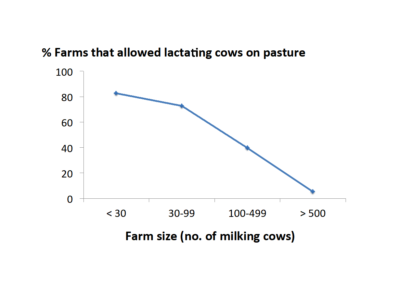
This decline in pasture access with increasing farm size may be due to a number of factors, including the logistical difficulties involved in providing meaningful grass availability within easy walking distance to that many cows. If so, this suggests that there is some upper limit to the number of dairy cows that can be housed in a single barn and still allow for meaningful pasture access. Of course, on larger farms animals could be subdivided into smaller barns (perhaps each served by an individual milking robot), and thus still allow for the efficient use of pasture. Also, from a welfare perspective, although cows like to spend time outside on pasture, they prefer to eat the prepared diets available indoors (Legrand et al., 2009). This allows for systems that separate the practice of pasture access from the practice of feeding grass, and opens up the potential of welfare friendly systems using more resilient (to heavy usage) but less productive grass varieties that allow for greater access to pasture by more cows.
Perhaps more importantly, we need to provide clear guidelines to farms about the types of practices that we (as a society) consider essential for our farm animals to have a good life. If some type of meaningful outdoor access is one such criterion (and we believe it is), then farms of different size will need to develop their own solutions for how best to include this practice, taking into account all the specific constraints of the individual farm. This may pose an additional challenge to large farms, but does not inherently mean that larger farms will be associated with poor practices or outcomes.
Closing remarks
In summary, we have reviewed some of the main arguments concerning why larger farms are perceived to provide farm animals with a poorer quality of life. Using examples of research on dairy cows, mostly taken from our group, we have shown that the relationship between farm size and cow welfare is not necessarily negative. Indeed, in some cases it seems that larger farms are able to provide for better welfare of their cows, as we initially illustrated with the data showing declining lameness rates with increasing farm size. We also showed how larger farms often preferentially benefit from technology that can, at least in some cases, improve welfare and that larger farms benefit from more professional management that can reduce some welfare risks. Nonetheless, we also discussed how larger farms maybe less likely to use some positive practices, like providing their cows pasture access.
However, in none of these cases do we see farm size as inherently associated with welfare. Smaller farms can sometimes benefit for positive technologies and practices first adopted by larger farms, or at least can use some of the lessons learned in terms of these benefits (such as early and more effective disease diagnosis). Indeed, some of the costs of developing professional procedures (such as the development of detailed standard operating procedures) can be preferentially borne by larger farms but then transferred for adoption to smaller farms.
Ultimately, we encourage readers to shift their focus away from size per se, and onto practices that can benefit animals on all farms. This will prevent the stigmatization of farmers simply on the basis of the size of their herd, and encourage a more positive discussion on what features can benefit the welfare of animals on all farms.
Acknowledgments
The UBC Animal Welfare Program is funded by the Natural Sciences and Engineering Research Council’s Industrial Research Chair program, with industry contributions from the Dairy Farmers of Canada (Ottawa, ON, Canada), British Columbia Dairy Association (Burnaby, BC Canada), Westgen Endowment Fund (Milner, BC, Canada), Intervet Canada Corporation (Kirkland, QC, Canada), Novus International Inc. (Oakville, ON, Canada), Zoetis (Kirkland, QC, Canada), BC Cattle Industry Development Fund (Kamloops, BC, Canada), Alberta Milk (Edmonton, AB, Canada), Valacta (St. Anne-de-Bellevue, QC, Canada), and CanWest DHI (Guelph, ON, Canada).
References
Beggs, D.S., A.D. Fisher, E.C. Jongman, P.H. Hemsworth. 2015. A survey of Australian dairy farmers to investigate animal welfare risks associated with increasing scale of production. J. Dairy Sci. 98:5330 – 5338.
Blayney, D. 2002. The changing landscape of U.S. milk production. USDA Statistical Bulletin No. SB-978. US Department of Agriculture Economic Research Service, Washington, DC.
Cardoso, C.S., M.J. Hötzel, D.M. Weary, J.A. Robbins, M.A.G. von Keyserlingk. 2016. Imagining the ideal dairy farm, J. Dairy Sci. 99:1663-1671.
Chapinal, N., A. Barrientos, M.A.G. von Keyserlingk, E. Galo, and D. M. Weary. 2013. Herd-level risk factors for lameness in freestall farms in northeastern US and California. J. Dairy Sci. 96:318-328.
Chapinal, N., Y. Liang, D.M. Weary, Y. Wang and M.A.G. von Keyserlingk. 2014 a. Risk factors for lameness and hock injuries in Holstein herds in China. J. Dairy Sci. 97:4309-4316.
Chapinal, N., D.M. Weary, L. Collings, M.A.G. von Keyserlingk. 2014 b. Lameness and hock injuries improve on farms participating in an assessment program. Vet. J. 202:646-648.
De Paula Vieira, A., V. Guesdon, A.M. de Passillé, M.A.G. von Keyserlingk, and D.M. Weary. 2008. Behavioural indicators of hunger in dairy calves. Appl. Anim. Behav. Sci. 109:180-189.
Fraser, D., 2005. Animal welfare and the intensification of animal production: an alternative interpretation. FAO Readings in Ethics No. 2. 32 pages. Food and Agriculture Organization of the United Nations (FAO), Rome.
Ito, K., M.A.G. von Keyserlingk, S.J. LeBlanc, and D.M. Weary. 2010. Lying behavior as an indicator of lameness in dairy cows. J. Dairy Sci. 93:3553-3560.
Robbins, J.A., M.A.G. von Keyserlingk, D. Fraser, and D.M. Weary. 2016. Invited Review: Farm size and animal welfare. J. Anim. Sci. 94:5439-5455.
Schuppli, C.A., M.A.G. von Keyserlingk, and D.M. Weary. 2014. Access to pasture for dairy cows: Responses from an on-line engagement. J. Anim. Sci. 92:5185-5192.
USDA. 2007. Dairy 2007, Part I: Reference of Dairy Cattle Health and Management Practices in the United States, USDA-APHIS-VS, CEAH. Fort Collins, CO.
USDA. 2016. Dairy 2014, Part I: Reference of Dairy Cattle Management Practices in the United States, USDA–APHIS–VS–CEAH–NAHMS. Fort Collins, CO.
von Keyserlingk, M. A. G., A. Barrientos, K. Ito, E. Galo, and D. M. Weary. 2012. Benchmarking cow comfort on North American freestall dairies: lameness, leg injuries, lying time, facility design and management, for high producing Holstein dairy cows. J. Dairy Sci. 95:7399-7408.
Waiblinger, S., and C. Menke. 1999. Influence of herd size on human-cow relationships. Anthrozoos 12:240-247.
Waiblinger, S., C. Menke, and D.W. Fölsch. 2003. Influences on the avoidance and approach behaviour of dairy cows towards humans on 35 farms. Appl. Anim. Behav. Sci. 84:23-39.


